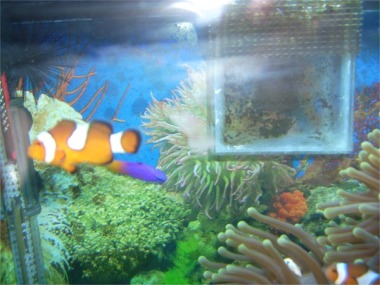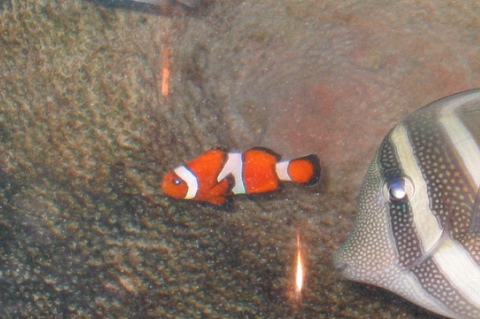|
|
|
|
The
genus name Amphiprion is a Greek word that means “saw on both
sides.” There are 28 different anemonefish species in the genus
Amphiprion. What separates the Amphiprion ocellaris from the
others is the fact that it rarely is seen outside of its host anemone
and is considered one of the most basal species in the group. Each
clownfish is orange with black markings on its fins. The body possesses a
white bar on its head, body and caudal peduncle, or the area between the
anal fin and the base of the caudal fin. The middle bar on the fish is
usually bulged towards the head of the species, making it thicker than
the others. A. ocellaris can grow to lengths of eight
centimeters and are closely related to the species Amphiprion percula.
The difference between these two species is that A. percula
usually has ten dorsal spines, while A. ocellaris has eleven.
Also, A. ocellaris have thin black bands separating the white
bands from the orange and is slightly less orange than the A. percula.
Another major difference between the two species is that clownfish have grayish orange irises
that make their eyes appear bigger than they are. A. percula
have bright orange irises, making their eyes appear smaller. For more information, see the
Home Page. |
|
|
|
|
|
One interesting study found that Amphiprion ocellaris living in hatcheries often developed retinal degeneration and other eye problems due to a Vitamin A deficiency in their diet. This problem occurred mainly during the summer months in about 10% of the hatchery fish, with 90% of those affected being females. This is surprising because the majority of clownfish are males! A problem was first discovered when the fish began to swim erratically. After continual testing, it was determined that the food being fed to the fish contained proteins for plants rather than animals and lacked the amount of vitamin A required by the clownfish. Once discovered, the problem was quickly corrected and very few problems have been reported since. Either way, it is still amazing that the imbalance of one vitamin can affect a creature that much! |
|
|
"Nemo" in
an aquarium in Virginia. |
The movie “Finding Nemo” has greatly increased the Amphiprion ocellaris popularity within the last four years, making this particular species the most commonly exported marine species today. This popularity has played a role in the population numbers of the clownfish, however. Many areas are being over-collected for trade. Another problem affecting the clownfish population is the increased destruction of coral reefs in which they live. This species is not considered endangered or threatened yet, but if things continue to way they are, it may be one day. (See also Interactions). |


